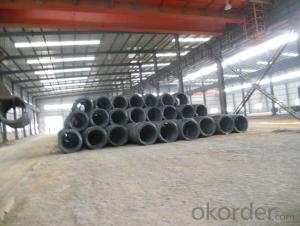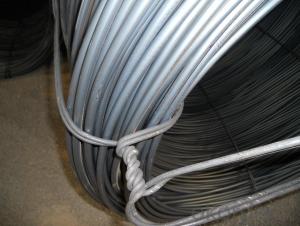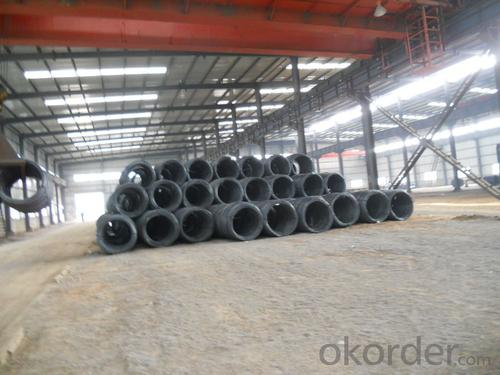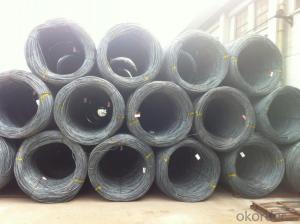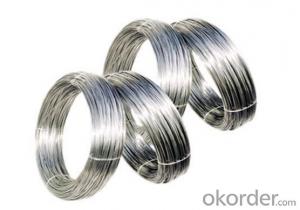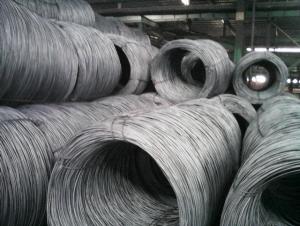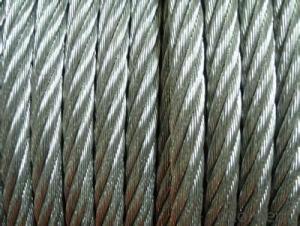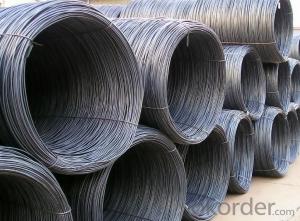Hot Rolled Steel Wire Rod SAE1006 SAE1008 SAE1018
- Loading Port:
- Tianjin
- Payment Terms:
- TT OR LC
- Min Order Qty:
- 500 m.t.
- Supply Capability:
- 40000 m.t./month
OKorder Service Pledge
OKorder Financial Service
You Might Also Like
Specification
Product Description:
OKorder is offering Hot Rolled Steel Wire Rod SAE1006 SAE1008 SAE1018 at great prices with worldwide shipping. Our supplier is a world-class manufacturer of steel, with our products utilized the world over. OKorder annually supplies products to European, North American and Asian markets. We provide quotations within 24 hours of receiving an inquiry and guarantee competitive prices.
Product Applications:
Hot Rolled Steel Wire Rod SAE1006 SAE1008 SAE1018 are ideal for structural applications and are widely used in the construction of buildings and bridges, and the manufacturing, petrochemical, and transportation industries.
Product Advantages:
OKorder's Hot Rolled Steel Wire Rod SAE1006 SAE1008 SAE1018 are durable, strong, and resist corrosion.
Main Product Features:
· Premium quality
· Prompt delivery & seaworthy packing (30 days after receiving deposit)
· Corrosion resistance
· Can be recycled and reused
· Mill test certification
· Professional Service
· Competitive pricing
Product Specifications:
Steel Grade: Q195/235, SAE1006-1018B Standard: ASTM, GB
Diameter: 5.5mm, 6.5mm, 7mm,8mm,9mm,10mm,12mm,14mm
Type: in coil, coil weight around 2MT Alloy or Not: Alloy
Technique: Hot Rolled Place of Origin: China Mainland
Surface: round, no twisted, light and smooth Brand Name: HSKY
Chemical Composition: (Please kindly find our chemistry of our material based on Q195、Q235A and Q235B as below for your information)
Trademark | Rank | Chemical composition (quality score) % | |||||
C | Si | Mn | S | P | |||
| ≤ |
| ≤ | ≤ | |||
Q195 |
| 0.06-0.12 | 0.30 | 0.25 | 0.050 | 0.045 | |
Q235 | A | 0.14-0.22 | 0.30 | 0.30-0.65 | 0.050 | 0.045 | |
Q235 | B | 0.12-0.20 | 0.30 | 0.30-0.70 | 0.045 | 0.045 | |
Usage and Applications of Wire Rod SAE1008B:
After hot-rolled the products shaped into coil and delivery as finished product, including round, square, rectangular, hexagonal and so on. Since most of the products are round, it is generally called wire rod. Carbon steel wire rod is widely used in construction and manufacturing. Carbon steel wire rod is mainly used for reinforcement of reinforced concrete and welded structure or reprocessed (roberts , nail, etc.) materials, especially used to produce wire drawing, welding electrode, nails, spring, electronic, precise machinery parts and so on.
FAQ:
Q1: Why buy Materials & Equipment from OKorder.com?
A1: All products offered byOKorder.com are carefully selected from China's most reliable manufacturing enterprises. Through its ISO certifications, OKorder.com adheres to the highest standards and a commitment to supply chain safety and customer satisfaction.
Q2: How do we guarantee the quality of our products?
A2: We have established an advanced quality management system which conducts strict quality tests at every step, from raw materials to the final product. At the same time, we provide extensive follow-up service assurances as required.
Q3: How soon can we receive the product after purchase?
A3: Within three days of placing an order, we will begin production. The specific shipping date is dependent upon international and government factors, but is typically 7 to 10 workdays.
Q4: What makes stainless steel stainless?
A4: Stainless steel must contain at least 10.5 % chromium. It is this element that reacts with the oxygen in the air to form a complex chrome-oxide surface layer that is invisible but strong enough to prevent further oxygen from "staining" (rusting) the surface. Higher levels of chromium and the addition of other alloying elements such as nickel and molybdenum enhance this surface layer and improve the corrosion resistance of the stainless material.
Q5: Can stainless steel rust?
A5: Stainless does not "rust" as you think of regular steel rusting with a red oxide on the surface that flakes off. If you see red rust it is probably due to some iron particles that have contaminated the surface of the stainless steel and it is these iron particles that are rusting. Look at the source of the rusting and see if you can remove it from the surface.
Images:
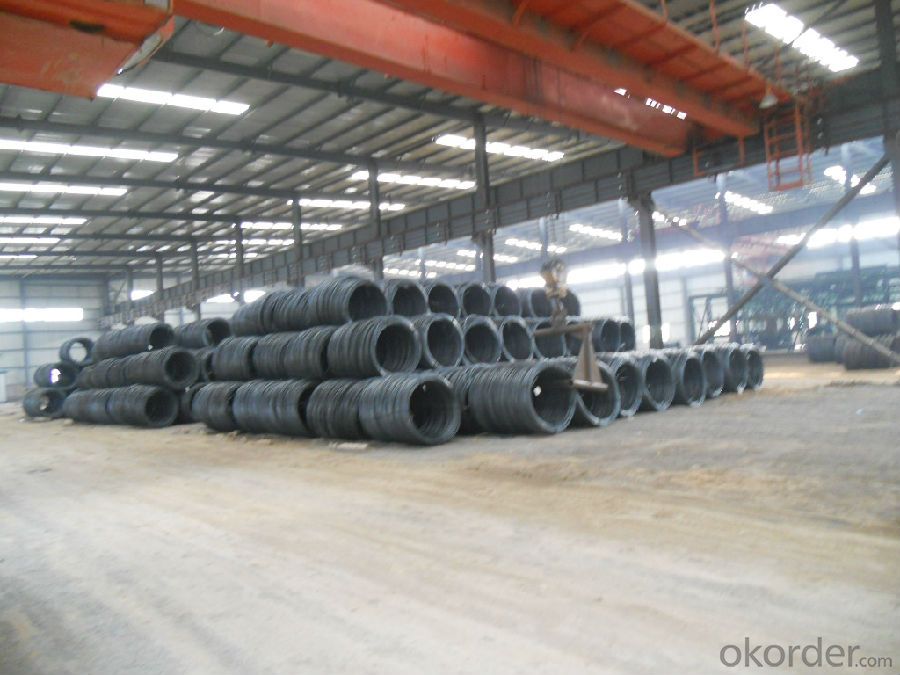
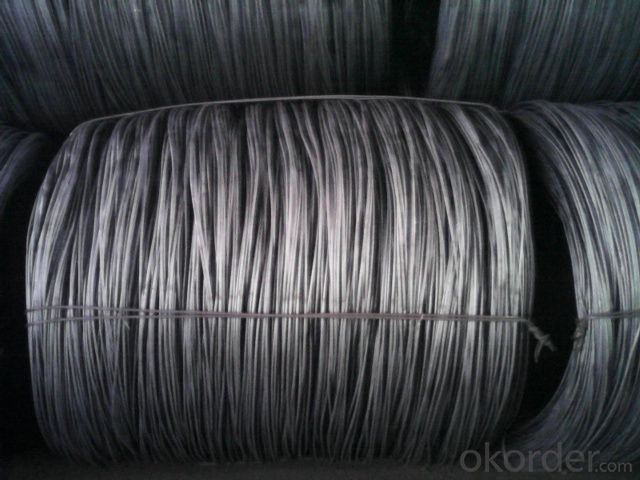
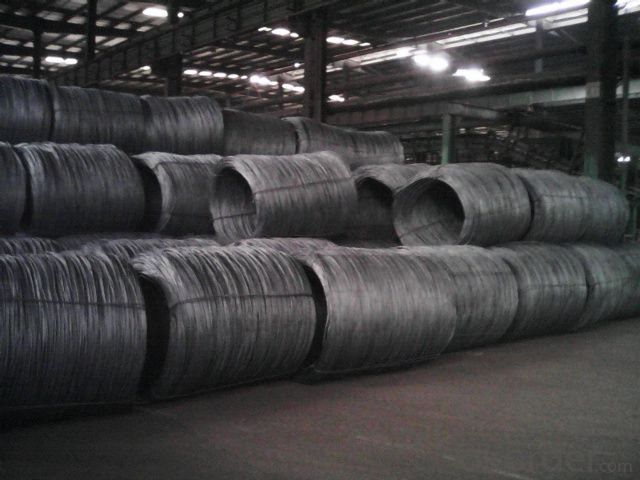
- Q: What is the maximum allowable deviation in diameter for steel wire rod?
- The maximum allowable deviation in diameter for steel wire rod varies depending on the specific industry standards and customer requirements. It is crucial to consult the relevant specifications or contact the manufacturer to obtain the accurate information for a particular steel wire rod product.
- Q: What are the common industry standards for steel wire rod professionals?
- The common industry standards for steel wire rod professionals include adherence to national or international specifications such as ASTM, DIN, or JIS, compliance with quality control measures like ISO 9001, and knowledge of industry best practices and safety protocols.
- Q: What are the different mechanical properties of steel wire rod?
- The different mechanical properties of steel wire rod include strength, elasticity, ductility, toughness, and hardness. These properties determine the wire rod's ability to withstand applied forces, resist deformation, exhibit flexibility, absorb energy, and resist wear and indentation, respectively.
- Q: What are the common production processes for chromium-coated steel wire rod?
- The common production processes for chromium-coated steel wire rod include surface preparation, electroplating, and finishing. The surface preparation involves cleaning and degreasing the steel wire rod to ensure a smooth and clean surface. Electroplating is then performed, where the wire rod is immersed in a chromium plating bath and an electric current is passed through it, causing chromium to deposit onto the surface. Finally, the wire rod goes through a finishing process, which may include polishing, buffing, or additional coatings to enhance the appearance and durability of the chromium-coated steel wire rod.
- Q: How is the diameter of a steel wire rod determined?
- The diameter of a steel wire rod is typically determined using a measuring instrument, such as a micrometer or caliper, which allows for precise measurements. The instrument is applied to the wire rod at multiple points along its length, and the average diameter is calculated based on these measurements.
- Q: How does the magnetic properties of steel wire rod vary with different heat treatment processes?
- The magnetic properties of steel wire rod can greatly differ depending on the heat treatment processes used. Heat treatment involves subjecting the rod to controlled heating and cooling to change its microstructure, which in turn affects its magnetic properties. One commonly used heat treatment process for steel wire rod is annealing. Annealing involves heating the rod to a specific temperature and then slowly cooling it to room temperature. This process helps relieve internal stresses, refine the grain structure, and enhance the ductility of the wire rod. In terms of magnetic properties, annealing decreases the magnetic permeability of the rod, making it less vulnerable to magnetic fields. This can be advantageous in applications where minimizing magnetic interference is important. Another heat treatment process for steel wire rod is quenching and tempering. Quenching involves rapidly cooling the wire rod from a high temperature to room temperature, usually by immersing it in a quenching medium like oil or water. This rapid cooling results in a hard and brittle structure called martensite. However, martensite is not magnetic and has low ductility. To improve the ductility and toughness of the wire rod, tempering is performed by reheating the quenched wire rod to a lower temperature and then allowing it to cool slowly. The tempering process partially transforms the martensite into a more ductile structure known as tempered martensite. The magnetic properties of the wire rod after quenching and tempering can vary depending on the composition and cooling rate during quenching, as well as the temperature and duration of the tempering process. In conclusion, different heat treatment processes can significantly affect the magnetic properties of steel wire rod. Annealing reduces the magnetic permeability, while quenching and tempering modify the microstructure and magnetic behavior of the rod. The choice of specific heat treatment process depends on the desired magnetic properties and the intended application of the steel wire rod.
- Q: What are the physical properties of steel wire rod?
- Steel wire rod has several physical properties that make it suitable for various applications. Firstly, it has high tensile strength, which allows it to withstand heavy loads and resist deformation. This property makes it ideal for use in construction, manufacturing, and engineering industries. Additionally, steel wire rod exhibits excellent ductility, meaning it can be easily bent or twisted without breaking. This flexibility makes it suitable for applications that require shaping or forming, such as in the production of wire products. Furthermore, steel wire rod possesses good thermal conductivity, allowing it to efficiently transfer heat. This property makes it useful in applications such as heating elements or electrical conductors. Lastly, steel wire rod is corrosion-resistant, which ensures its longevity and durability in various environmental conditions. Overall, the physical properties of steel wire rod make it a versatile and reliable material for a wide range of applications.
- Q: What are the safety considerations when handling steel wire rod?
- When handling steel wire rod, it is important to consider several safety measures. Firstly, proper personal protective equipment (PPE) such as gloves, safety glasses, and steel-toed boots should be worn to protect against potential injuries. Additionally, workers should be trained on safe lifting techniques and ensure that the weight of the steel wire rod is within their physical capabilities. It is crucial to maintain a clean and organized work area to prevent trips, slips, and falls. Workers should also be cautious of sharp edges and points on the wire rod, using appropriate tools and handling methods to avoid cuts or punctures. Lastly, proper storage and handling practices should be followed to prevent the wire rod from rolling or falling, potentially causing injuries to workers or damage to property.
- Q: What are the common production processes for hassium-coated steel wire rod?
- The common production processes for hassium-coated steel wire rod typically involve several steps. Firstly, the steel wire rod is cleaned thoroughly to remove any impurities or contaminants. Next, it undergoes a coating process where a layer of hassium is applied onto the surface of the wire rod using various techniques such as physical vapor deposition or electroplating. This coated wire rod is then subjected to a curing process, which helps in enhancing the adhesion and durability of the hassium coating. Finally, the wire rod is inspected for quality control purposes before it is ready for further use in various industries.
- Q: What are the standard hardness requirements for steel wire rod?
- The standard hardness requirements for steel wire rod are contingent upon various factors, including the intended use and specific industry standards. However, there exist some general principles that can be adhered to. In most instances, the hardness of steel wire rod is gauged using the Rockwell hardness scale. The particular Rockwell hardness (HRC) requirement may differ based on the grade and type of steel wire rod. For instance, low carbon steel wire rod typically falls within the range of 45 to 55 HRC, whereas high carbon steel wire rod may necessitate a hardness requirement of 55 to 65 HRC. Moreover, industry standards like ASTM (American Society for Testing and Materials) or ISO (International Organization for Standardization) may proffer specific hardness requirements for different grades and applications of steel wire rod. These standards guarantee that the wire rod satisfies the requisite mechanical properties for its intended use, encompassing strength, ductility, and wear resistance. It is important to note that the hardness requirements for steel wire rod can also be influenced by customer specifications or specific manufacturing processes. For example, wire rods employed in the production of springs or cables may necessitate more stringent hardness requirements in comparison to those utilized for general applications. Ultimately, it is advisable to consult the pertinent industry standards, customer specifications, or specific product requirements to ascertain the standard hardness requirements for steel wire rod within a given context.
Send your message to us
Hot Rolled Steel Wire Rod SAE1006 SAE1008 SAE1018
- Loading Port:
- Tianjin
- Payment Terms:
- TT OR LC
- Min Order Qty:
- 500 m.t.
- Supply Capability:
- 40000 m.t./month
OKorder Service Pledge
OKorder Financial Service
Similar products
Hot products
Hot Searches
Related keywords
